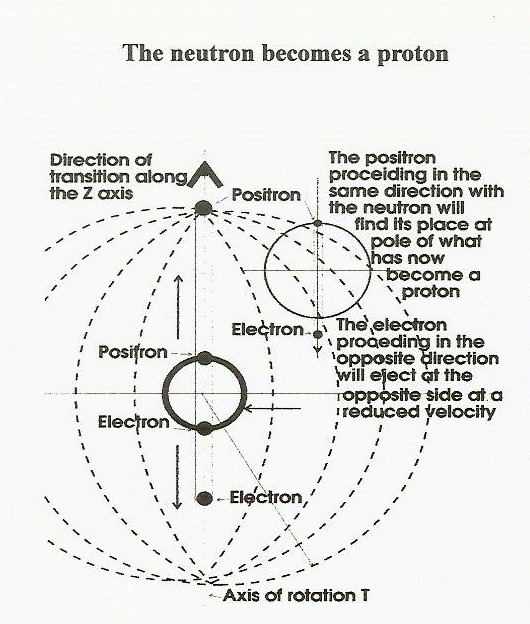The Proton source
(See
fig. 12)
The pProton physical characteristics
are similar to the Neutron's. The Neutron radius was experimentally found to be equal to l0 -20 m It's
mass at 939.56563 Mev, its charge equal to zero Coulombs. In our hypothesis a Proton spherical volume containing the trajectories
of the imprisoned intensity impulses has approximately the radial dimension that was found for a Neutron. The Proton mass
was found to be 938.27231 Mev, slightly smaller than the neutron, its charge equals to the Electron but opposite in sign.
The Proton mass is then lighter than the Neutron by 1.29332 Mev. Since the Electron mass is equal to 0.51099906 Mev, the difference
between the Neutron and the Proton is approximately 2,53 Electron masses. In describing the Neutron in chapter 11, we did
not mention the fact that when present in a non radioactive Nucleus its life span searns to be infinite, but in an independent
state the Neutron will, in an average 12 minutes of time, turn into a Proton, a particle that, in a similarity with the Electron
seams to have an infinite life span. * It was found through experimentation that when the Neutron turns into a Proton it ejects
an Electron. The total kinetic energy of the system resulting from this event should be equal to 1.29 MeV, representing the
difference in energy lost from the Neutron in the transfonnation, this of course in order to obey the law of conservation
of energy. The results experimentally observed were not those expected. In the transfonnation of a Neutron into a Proton,
the energy of the ejected Electron appears in a wide range of values consistently vithin a certain minimum and a maximum value,
but never accounting for 1.29 MeV. The electron is also ejected from the Neutron in a wide range of different angles. In order
to save the conservation laws a new particle responsible for the missing energy had to be created and was named "Neutrino."
Neutrinos have no mass, but possess energy and radiate in space with the velocity of light, The reason why the Neutron will
turn into a Proton in an average, 12 minutes of time must be due to the previously stated general law governmg the distribution
of energy in the field when localizing in spherical sources. The time in the life span of every known particle is linked to
a number of events that can be measured through mathematical analysis.
We will try to illustrate the transfonnation of a Neutron into a Proton within the premises of the proposed
new atomic model, following a classical configuration of three cardinal axises and a dimension in time. I am here proposing
that the Neutron, while in a free state, will turn into a Proton in the following way. (See sketch12) When a free Neutron
source advancing along the T axis reaches a particular specific level of energy and transitional velocity it will originate
an implosion resulting at this time in the separation from the Neutron physical mass of two spherical energy sources, each
equal in size to an Electron, and the original volume now diminished to the size of a Proton plus a certain amount of energy.
These two Electron size sources formed on the T axis of rotation will through the additional energy released in the transformation
proceed in opposite directions along that axis. The rotation imposed around the spinning T axis on the two newly released
sources, will in consequence establish the direction of their revolutions' with respect to their velocity vector. The
resulting direction of rotation must occur in opposite ways, one being clockwise and the other counterclockwise. The two sources
will emerge then as an Electron at one end and a Positron at the other. I will have to assume that the source emerging in
the direction of the velocity of transition of the neutron will add that velocity to its own and proceed with the Neutron
source as a Positron, while the opposite source will emerge with a diminished velocity and a lower energy status as an Electron.
Due to the rotation of the Neutron XY plane the emerging source 'will emerge at a different angles from the original direction.
The kinetic energy of the emerging Electron source and therefore its velocity will vary from case to case depending on the
original energy (and therefore velocity) originally possessed by the Neutron. The variance in kinetic energy and momentum
of the emerging Electrons can this way be explained without the necessity of Inventing a particle. Since the regular implosions
generating intensity impulses have resumed in what it is now a Proton source, the positive charge added by the presence of
a newly created Positron will maintain its position at a distance from its center equal to:
10 -20 m
This constant distance maintained by the Positron in its revolutions around the Proton is the result of a combination
of its natural transitional velocity and the strong Implosion forces, being generated at that distance by the Proton source.
In the following faze the Electron, in an opposite
path from the Positron, will escape from the Neutron with varying degrees of kinetic energy and angular momentum, this way
being detected as a separate particle. The Proton source can than be described as a Neutron source slightly diminished in
size and energy with a Positron source revolving around it at a distance, designing an orbit that is balanced between its
own transitional velocity and the strong implosion forces generated by the Proton. The Proton is with the Electron the only
particle whose life span seams to be infinite in time.
* In the quantum grand uniflcation theory, the particle identified as a Proton, is composed by others particles called
Quarks
